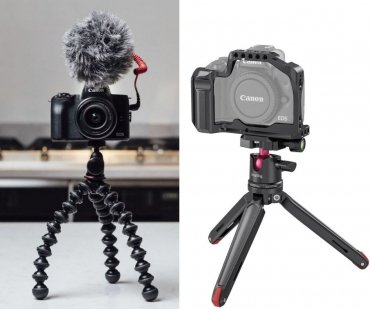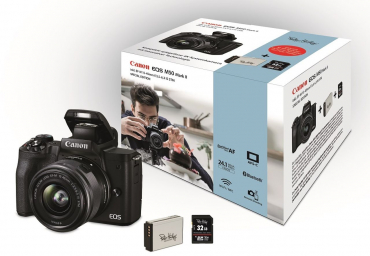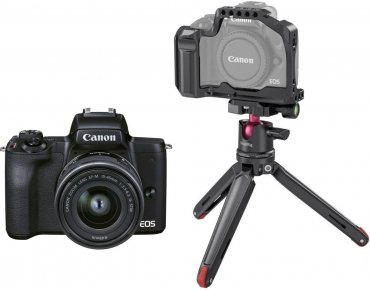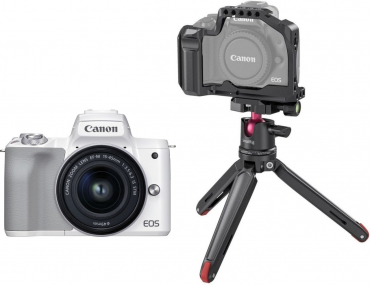Canon EOS M - Compact System Cameras with Good Performance
Fans of the manufacturer have had to wait a long time for the mirrorless system cameras marketed by Canon as the EOS M series. While other manufacturers such as Sony, Nikon and Pentax had already discovered the new market for themselves, Canon was able to observe the new DSLM market in peace and analyse the mistakes and successes of the competition because of the flourishing DSLR business. This experience then flowed into the development of the new Canon system cameras. Just like the Nikon models, they are mainly aimed at hobby photographers who want to achieve good image results quickly and easily without having to torture themselves through numerous setting menus. Accordingly, the EOS M models have very few controls. While the mode dial on Canon's DSLRs is very extensive, it offers far fewer options on the EOS M models. Here, you can only choose between a photo mode, where you have certain manual intervention options, the full auto mode with automatic scene recognition and the movie mode for high-resolution videos.
The Canon DSLMs are also very compact on the outside. They are no bigger than a compact camera, have a robust magnesium housing and are generally of a high quality. This should ensure a long service life. In addition, Canon's system cameras are easy to hold in one hand, even though they do not have a real grip. The complete operating concept shows that Canon wants to set itself apart from the professional SLR models with the EOS M cameras. This concept is also successfully pursued by the competitor Nikon. Despite the rudimentary functions and the compact dimensions, the EOS M models allow you to use optional equipment. This is made possible by an accessory shoe that serves for expansion. In addition, the system cameras can be upgraded with a small clip-on flash, which can also be used to control external Speedlite system flashes wirelessly.
Are you unsure whether the Canon EOS M models are the right camera system for you? Then read on in the lower section of the website, because there you will find a lot more information as well as the most important advantages and disadvantages of the system cameras compared to the DSLRs.
What are the special features of the system camera compared to the DSLR?
The main difference between DSLMs and DSLRs is that the DSLM does not have an internal mirror. In a DSLR, the mirror is used to redirect the image produced by the sensor to the viewfinder. During the shot, the mirror flips over to allow the light a clear path to the sensor and begin the exposure of the shot. With a DSLM, there is no such mirror. The biggest advantage of compact system cameras compared to DSLRs is therefore that they are much smaller and lighter in weight. The lack of a mirror means that the weight can be reduced considerably. In addition, you don't have to clean the mirror, which is often necessary with DSLRs. In terms of sensor size, most system cameras do not differ from DSLRs. Accordingly, they deliver equally high image quality.
Canon EOS M series relies on technology from mid-range DSLRs
The system cameras from Canon are equipped with technology from mid-range DSLRs. This is true, for example, of the DSLMs' displays, which are high-resolution, large and touchscreen, just like the modern three-digit DSLRs. When touched, the displays respond fluidly and quickly - even in the corners. The menu layout is also essentially similar to Canon's DSLRs. With the system cameras, you can select the aperture and exposure time directly via the display. There are also various exposure modes to choose from. The touchscreen operation proves particularly useful in image playback mode. For example, you can zoom into an image with two fingers just like on a smartphone or tablet. A good video mode is also on board with all Canon system cameras. The sound can be determined manually. If the internal microphone does not provide a good enough sound, you have the option of connecting an external microphone. This increases the voice reproduction of the recorded videos considerably.
The Canon EOS M models deliver a convincing image quality
The image quality of the Canon EOS M models also leaves hardly anything to be desired. They use a CMOS sensor in APS-C format with a high resolution. The same sensors are also used in modern three-digit DSLRs, so the system cameras are in no way inferior to these models in terms of image quality. This is an advantage over Nikon's system cameras, which use the smaller CX sensor. It tends to produce more image noise at higher ISO values. Especially in low light conditions, the Nikon system cameras therefore perform somewhat worse. The situation is different in this respect with the EOS M models: They can definitely keep up with the mid-range DSLRs in terms of image noise. In plain language, this means that with a Canon EOS M you can take a photo at ISO 3200 and still print it out in a size up to A3. You will hardly notice any spurious pixels or noise. If you look at a photo of an EOS M on a computer monitor, you will notice a slight noise in the 100 percent view from ISO 1600. However, this is also the case with Canon's mid-range SLR cameras.
Advantages and disadvantages of Canon's system cameras compared to DSLRs
Finally, we have compiled a list for you that gives you an overview of the important advantages and disadvantages of Canon's system cameras.
Among the advantages are:
Does not require complex mechanics, which is why the housing can be kept more compact
Weighs significantly less than DSLRs
The viewfinder displays the image as it is then captured on the memory card
A viewfinder display is also possible during shooting
Lower cost to purchase
The range of functions is reduced to the bare essentials
However, a Canon system camera also has disadvantages:
Battery life is shorter because the electric viewfinder consumes more power
The electric viewfinder can be blinding in low ambient light
The lens selection is not as wide as with DSLRs
Whether a DSLM from Canon is right for you therefore also depends primarily on your personal requirements and the shooting situations you plan to use it for.




Simply subscribe and benefit as a newsletter recipient every week: